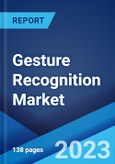The global gesture recognition market size reached US$ 16.4 Billion in 2023. Looking forward, the publisher expects the market to reach US$ 89.0 Billion by 2032, exhibiting a growth rate (CAGR) of 20.67% during 2023-2032.
Gesture recognition is a perceptual user interface (PUI) that captures and interprets human motions to control devices or applications. It relies on a camera for feeding image data into a sensing device and a software correlates it with a predetermined gesture library. Once the gesture is interpreted, the computer focuses on the execution of the user’s command. At present, gesture recognition is rapidly gaining traction in virtual reality (VR) and augmented reality (AR) environments to assist e-learning.
The incorporation of gesture recognition technology to provide an interactive and realistic gaming experience, along with the rising number of professional gamers, represents one of the key factors bolstering the market growth. Moreover, wearables with gesture recognition are finding extensive application in the healthcare industry to offer contactless navigation of X-ray display and magnetic resonance imaging (MRI). Apart from this, leading automotive manufacturers are integrating gesture recognition in different systems, such as air conditioning, windows and windshield wipers, to reduce driver workload and allow safe driving.
Furthermore, the emerging automation trend in industrial processes is escalating the demand for robots, which, in turn, is driving the market growth. Additionally, the technology is being utilized to manage photos and files and initiate online payments via smartphones. Besides this, the rising adoption of contactless methods for performing different tasks in various end use industries, coupled with a shift towards e-learning solutions, due to the coronavirus disease (COVID-19) outbreak, is anticipated to impact the market positively.
Gesture recognition is a perceptual user interface (PUI) that captures and interprets human motions to control devices or applications. It relies on a camera for feeding image data into a sensing device and a software correlates it with a predetermined gesture library. Once the gesture is interpreted, the computer focuses on the execution of the user’s command. At present, gesture recognition is rapidly gaining traction in virtual reality (VR) and augmented reality (AR) environments to assist e-learning.
The incorporation of gesture recognition technology to provide an interactive and realistic gaming experience, along with the rising number of professional gamers, represents one of the key factors bolstering the market growth. Moreover, wearables with gesture recognition are finding extensive application in the healthcare industry to offer contactless navigation of X-ray display and magnetic resonance imaging (MRI). Apart from this, leading automotive manufacturers are integrating gesture recognition in different systems, such as air conditioning, windows and windshield wipers, to reduce driver workload and allow safe driving.
Furthermore, the emerging automation trend in industrial processes is escalating the demand for robots, which, in turn, is driving the market growth. Additionally, the technology is being utilized to manage photos and files and initiate online payments via smartphones. Besides this, the rising adoption of contactless methods for performing different tasks in various end use industries, coupled with a shift towards e-learning solutions, due to the coronavirus disease (COVID-19) outbreak, is anticipated to impact the market positively.
Key Market Segmentation:
The publisher provides an analysis of the key trends in each sub-segment of the global gesture recognition market report, along with forecasts at the global, regional and country level from 2024-2032. Our report has categorized the market based on technology and end use industry.Breakup by Technology:
- Touch-Based
- Touchless
Breakup by End Use Industry:
- Consumer Electronics
- Automotive
- Aerospace and Defense
- Healthcare
- Others
Breakup by Region:
- North America
- United States
- Canada
- Asia-Pacific
- China
- Japan
- India
- South Korea
- Australia
- Indonesia
- Others
- Europe
- Germany
- France
- United Kingdom
- Italy
- Spain
- Russia
- Others
- Latin America
- Brazil
- Mexico
- Others
- Middle East and Africa
Competitive Landscape:
The competitive landscape of the industry has also been examined along with the profiles of the key players being Apple Inc., Cognitec Systems GmbH, EyeSight Technologies Ltd, Infineon Technologies AG, Intel Corporation, Microchip Technology Incorporated, Microsoft Corporation, QUALCOMM Incorporated, Sony Corporation and Synaptics Incorporated.Key Questions Answered in This Report:
- How has the global gesture recognition market performed so far and how will it perform in the coming years?
- What has been the impact of COVID-19 on the global gesture recognition market?
- What are the key regional markets?
- What is the breakup of the market based on the technology?
- What is the breakup of the market based on the end use industry?
- What are the various stages in the value chain of the industry?
- What are the key driving factors and challenges in the industry?
- What is the structure of the global gesture recognition market and who are the key players?
- What is the degree of competition in the industry?
Table of Contents
1 Preface3 Executive Summary10 Value Chain Analysis12 Price Analysis
2 Scope and Methodology
4 Introduction
5 Global Gesture Recognition Market
6 Market Breakup by Technology
7 Market Breakup by End Use Industry
8 Market Breakup by Region
9 SWOT Analysis
11 Porters Five Forces Analysis
13 Competitive Landscape
List of Figures
List of Tables
Companies Mentioned
- Apple Inc.
- Cognitec Systems GmbH
- EyeSight Technologies Ltd
- Infineon Technologies AG
- Intel Corporation
- Microchip Technology Incorporated
- Microsoft Corporation
- QUALCOMM Incorporated
- Sony Corporation
- Synaptics Incorporated
Methodology

LOADING...
Table Information
| Report Attribute | Details |
|---|---|
| No. of Pages | 142 |
| Published | August 2024 |
| Forecast Period | 2023 - 2032 |
| Estimated Market Value ( USD | $ 16.4 Billion |
| Forecasted Market Value ( USD | $ 89 Billion |
| Compound Annual Growth Rate | 20.7% |
| Regions Covered | Global |
| No. of Companies Mentioned | 10 |









